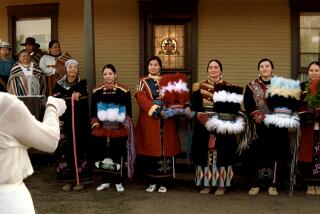A displeased actor, haunted lead star and busy costumer
- Share via
Rodney A. Grant, an Omaha Indian from Nebraska who plays Wind In His Hair in “Dances With Wolves,” thought the Indians were treated as secondary characters in the “Son of Morning Star” script.
“They were like extras in the background,” said Grant, who portrays the legendary Crazy Horse. “I haven’t seen it yet. I had some good scenes, but most of the fuss was on Gary Cole and the Calvary.”
Grant believes Custer is still a hero because white America is “hurting for a hero. It’s just the people who make the most waves and he happened to be it. He happened to have a passion for fighting Indians and he made a name for himself.
“Communication wasn’t as easy and accessible as it is today,” Grant said. “They heard everything through the grapevine and you know how the grapevine is. So they glorified him. Today, they ( white men) have trouble grasping that because they don’t want his image tarnished. If they listened to the true facts, I don’t think they would feel the way they do.”
Gary Cole found it very spooky when he visited the Custer Battlefield before he began filming “Son of the Morning Star.”
“There’s a lot of real weird karma up there,” said Cole, the star of NBC’s “Midnight Caller.” “But I didn’t form any kind of side or opinion on Custer. I just wanted to make sure I was believable.
“I don’t think the movie takes sides, though there are aspects of his arrogance throughout, which could be part of what led to the world’s most famous mistake. I believe the guy is a lot more famous because he was slaughtered than he ever would have been if he had lived to tell about it.”
Cathy Smith, a 19th-Century Plains Indian expert, native of South Dakota’s Black Hills and supervisor of Indian protocol for “Dances With Wolves,” made all the Indian costumes for “Son of the Morning Star.”
“There were eight different tribes represented over a 10-year-period,” Smith said. “When they moved to reservations they adopted more of the white man’s clothes, so we had to try and show that change within each tribe.”
Smith had only eight weeks to make nearly 200 costumes. “We used hundreds of deerskins, thousands of feathers,” she said. “I had two other people help me. We made 300 pairs of moccasins, all hand sewn. I just had to guess on what sizes to make. We would alter things and sew things up on the day of the shoot.”
Designing Crazy Horse’s clothing was a bit of a problem. He never allowed himself to be photographed. “No one knows what he looked like,” Smith said. “He is a cultural hero and the last of the warriors to give up. It was an enormous responsibility to dress him properly.”
Smith found a shirt of Crazy Horse’s at the Museum of the American Indian in New York and made an exact replica of it. “It is rubbed with blue earth paint on the upper half and yellow okra on the bottom half and has human hairlocks on it,” she said. “They represent the spirit of the people. He is wearing the spirit of all of the people. There is no bead work, because Crazy Horse was known to be a simple man.”
More to Read
Only good movies
Get the Indie Focus newsletter, Mark Olsen's weekly guide to the world of cinema.
You may occasionally receive promotional content from the Los Angeles Times.











